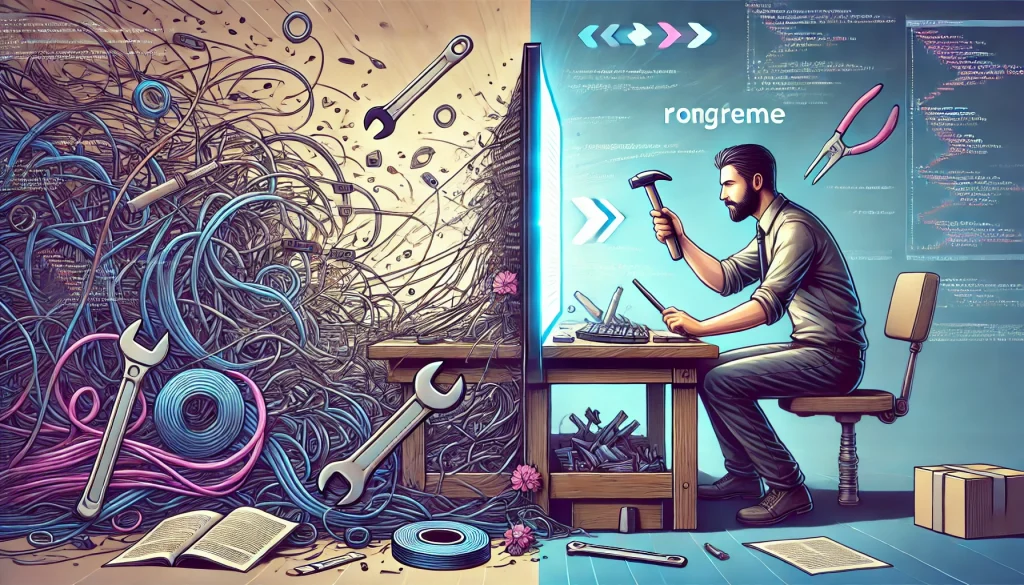Maintaining old, messy codebases is a fact of life for most developers. Surveys indicate engineers spend 20–50% of their time dealing with legacy systems, refactoring, and fixing bugs that accumulate over years of piecemeal development. However, detailed, step-by-step resources on how to systematically improve these aging systems can be hard to find. This guide will walk you through the crucial steps and considerations when dealing with legacy code and technical debt.

1. What Is Legacy Code?
1.1 Defining “Legacy”
Legacy code doesn’t necessarily mean “old.” Instead, it’s code that is difficult to change due to:
- Lack of tests
- Outdated or no documentation
- Complex, spaghetti-like architecture
- Obsolete frameworks or libraries
Even a six-month-old codebase can be “legacy” if it’s hard to modify confidently.
1.2 Technical Debt Explained
“Technical debt” is a metaphor describing the implied cost of expedient solutions that get the job done quickly but create maintenance burdens later. Debt must be “paid back” by dedicating time to refactoring, testing, and updates. If left unmanaged, it accumulates, slowing development and risking system instability.
2. Why Refactoring Legacy Code Matters
- Improved Maintainability
- Clean, well-structured code is easier to read, debug, and extend.
- Reduced Defects
- Spaghetti code fosters hidden bugs. Refactoring clarifies logic and reveals issues.
- Faster Feature Delivery
- When a codebase is tidy, new features can be implemented with less friction.
- Team Morale
- Working on well-organized code is more fulfilling than hacking around tangles.

3. Key Challenges in Legacy Refactoring
3.1 Fear of Breaking Existing Functionality
Developers are often risk-averse with legacy code. Without proper tests, each change can introduce regressions that are hard to detect until production. Hence, the code remains “frozen.”
3.2 Unclear Architecture & Documentation
Legacy systems might use older design patterns or contain partial rewrites with inconsistent styles. The architecture that emerges can be impossible to wrap your head around quickly—especially if no up-to-date diagrams or docs exist.
3.3 Time Constraints & Business Pressures
Teams often face tight deadlines for new features. Managers may resist significant refactoring efforts if they don’t see immediate value. Balancing short-term business needs with long-term health of the code is a perpetual conflict.
4. Strategies for Tackling Legacy Code
4.1 Start with Unit and Integration Tests
Goal: Ensure you can verify functionality before and after changes.
- Characterization Tests: Write tests that capture current behavior, even if it’s buggy or unexpected. This “locks in” the legacy code’s known outcomes.
- Incremental Coverage: Begin testing small modules or functions—particularly high-risk or frequently changing areas.
Tip: Tools like approvaltests or golden files can help capture output for quick comparisons if the code is too tangled for standard unit testing.
4.2 Adopt a Boy Scout Rule
Whenever you touch code—fixing a bug or adding a feature—leave it better than you found it. Rename confusing variables, simplify loops, add clarifying comments, or break up huge methods. This approach gradually improves the entire codebase over time.
4.3 Identify “Quick Wins” and “Big Rocks”
- Quick Wins: Minor improvements (e.g., removing dead code, renaming cryptic functions) that yield immediate clarity.
- Big Rocks: Major refactors (architecture changes, library upgrades) that require more planning and possibly business sign-off. Balance quick wins with scheduled big rock tasks so you see progress without overwhelming risk.
4.4 Strangler Fig Pattern
When dealing with especially ancient systems, the Strangler Fig pattern is a structured approach:
- Introduce a New Service or Module that replaces a small slice of the legacy functionality.
- Redirect traffic or data flows to this new component.
- Gradually Expand the new component’s responsibility until it replaces large parts of the old system.
This pattern allows incremental modernization without a high-stakes “big bang” rewrite.
5. Modern Tools and Techniques
5.1 Code Review Automation
- Static Analysis Tools: Checkstyle, ESLint, or SonarQube catch style issues, potential bugs, and code smells.
- Linting & Formatting: Automated formatters (Prettier, Black, clang-format) enforce consistent style.
5.2 Continuous Integration (CI)
A robust CI pipeline runs tests on every commit. This immediate feedback fosters safe refactoring—if you break something, you’ll know quickly.
5.3 Automated Refactoring Tools
Many IDEs (e.g., IntelliJ, Visual Studio) include advanced refactoring features (extract method, rename symbol, inline variable) that ensure code changes remain correct across the project.
5.4 Feature Toggles
Use feature flags to deploy refactored components or new code paths in production without risking the entire system. If issues arise, you can turn off the flag for a quick rollback.
6. Dealing with Management and Stakeholders
6.1 Communicate ROI
Refactoring can seem like a purely technical undertaking. However, highlighting benefits like fewer production incidents, faster feature implementation, or easier onboarding of new developers can secure management support.
6.2 Create a “Tech Debt Register”
Keep a running list of known issues, architecture problems, or outdated dependencies. Estimate time to fix, potential impact, and priority. This transparency helps stakeholders see the backlog and weigh it against feature requests.
6.3 Schedule Regular Maintenance Windows
Set aside a predictable slot (e.g., one day every sprint) for tackling technical debt. This habit prevents indefinite postponement of necessary cleanup.
7. Example Refactoring Workflow
- Identify a Painful Module: A class with frequent bugs or that devs dread touching.
- Add or Improve Tests: Write basic characterization tests.
- Refactor Internally: Use small, safe transformations—renames, extracting methods, or reorganizing logic.
- Verify Tests & Merge: CI checks that code still passes all tests.
- Rinse & Repeat: Over multiple sprints, tackle additional modules or bigger changes once you have momentum and stakeholder buy-in.
Conclusion
Refactoring legacy code and managing technical debt can feel daunting, especially under business pressures and incomplete documentation. Yet, incremental improvements—starting with tests, employing modern tooling, and practicing daily cleanup—dramatically enhance maintainability. Communicating the tangible benefits to both the team and management fosters an environment where consistent refactoring is seen as an investment rather than a cost.

Key Takeaways:
- Begin by adding tests that capture current behavior, ensuring stability through refactors.
- Adopt small, continuous improvements (Boy Scout rule) while planning major structural changes carefully.
- Use modern CI/CD and static analysis to automate checks and detect regressions early.
- Engage stakeholders by highlighting ROI and systematically tracking technical debt.
Over time, these practices help transform even the most archaic codebase into a maintainable system that supports future growth and developer happiness.












